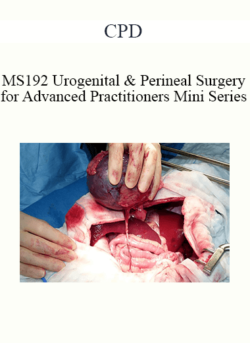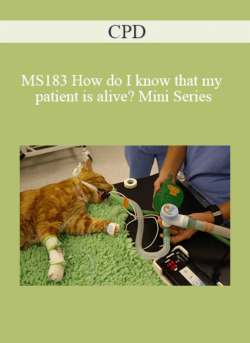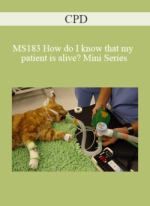[Pre-Order] – Deliver digital download link within 4-8 business days after successful payment. Please contact us to get more details. Purchase CPD – MS183 How do I know that my patient is alive? Mini Series courses at here with PRICE $479 $114MS183 How do I know that my patient is alive? Mini Series£347.00 (+VAT)12 months access to recordings and course materials is included. Please note that these are webinar recordings and not live events. Full details on how to access the Mini Series will be emailed to you. Join Adam Auckburally BVSc CertVA DipECVAA MRCVS for three 2-hour online sessionsComprehensive notes to downloadedSelf-assessment quizzes to ‘release’ your 8 hours CPD certification (don’t worry, you can take them more than once if you don’t quite hit the mark first time)A whole year’s access to recorded sessions for reviewing key pointsSuperb value for money – learn without travellingWatch the recordings on your iPad!This Mini Series was originally broadcast in August 2018! ProgrammeSession 1Pulse OximetryWhat does that number actually mean? Despite many practices owning a pulse oximeter, it is often never used, or when it is used there is confusion when interpreting the number displayed. In most instances turning up the oxygen flow is not the answer. Covered in this session will be:An introduction to the basic science of oxygen carriage and deliveryHow to interpret the number displayed on the monitorDiagnosis of the causes of hypoxaemia and how to deal with themCase scenarios Session 2CapnographyNow it’s time to drag that monitor out from under the anaesthetic machine! This is another piece of equipment that is rarely used in practice – for many the cost of equipment such as this precludes its use and it may only be used in ‘high risk’ cases. In this session you will learn about:Why capnography is THE most useful piece of monitoring equipmentThe basic science of carbon dioxide production and eliminationShapes and waveforms – how to interpret themETCO2 and how to interpret the numberDiagnosis of hypocapnia and hypercapnia and how to deal with them Session 3Blood Pressure and Basic electrocardiography for the anaesthetistMany practices own a Doppler machine, but fewer will have oscillometric devices for measurement of blood pressure. Additionally, real-time ECG analysis in the anaesthetised patient is very rarely carried out, and if it is, is often a source of panic when things go awry. Discussed in this final session will be:An introduction to the physiology of blood pressureHow to measure blood pressure non-invasively and get reliable resultsA short introduction to invasive blood pressure measurementsHow to interpret some of the real-time ECG patterns commonly observed in animals under anaesthesiaHow not to panic!When and how to deal with common ECG abnormalitiesRecognition of cardiac arrest – what is an ‘arrest pattern’Salepage: https://cpd-solutions.com/store/product/ms183-how-do-i-know-that-my-patient-is-alive-mini-series-august-2018/Archive: https://archive.ph/wip/3sIR0Purchase CPD – MS183 How do I know that my patient is alive? Mini Series courses at here with PRICE $479 $114
 CPD – MS192 Urogenital and Perineal Surgery for Advanced Practitioners Mini Series (November 2018)
₹18,924.00
CPD – MS192 Urogenital and Perineal Surgery for Advanced Practitioners Mini Series (November 2018)
₹18,924.00
 CPD – Ophthalmology Mini Bundle
₹30,378.00
CPD – Ophthalmology Mini Bundle
₹30,378.00
CPD – MS183 How do I know that my patient is alive? Mini Series
₹18,924.00





